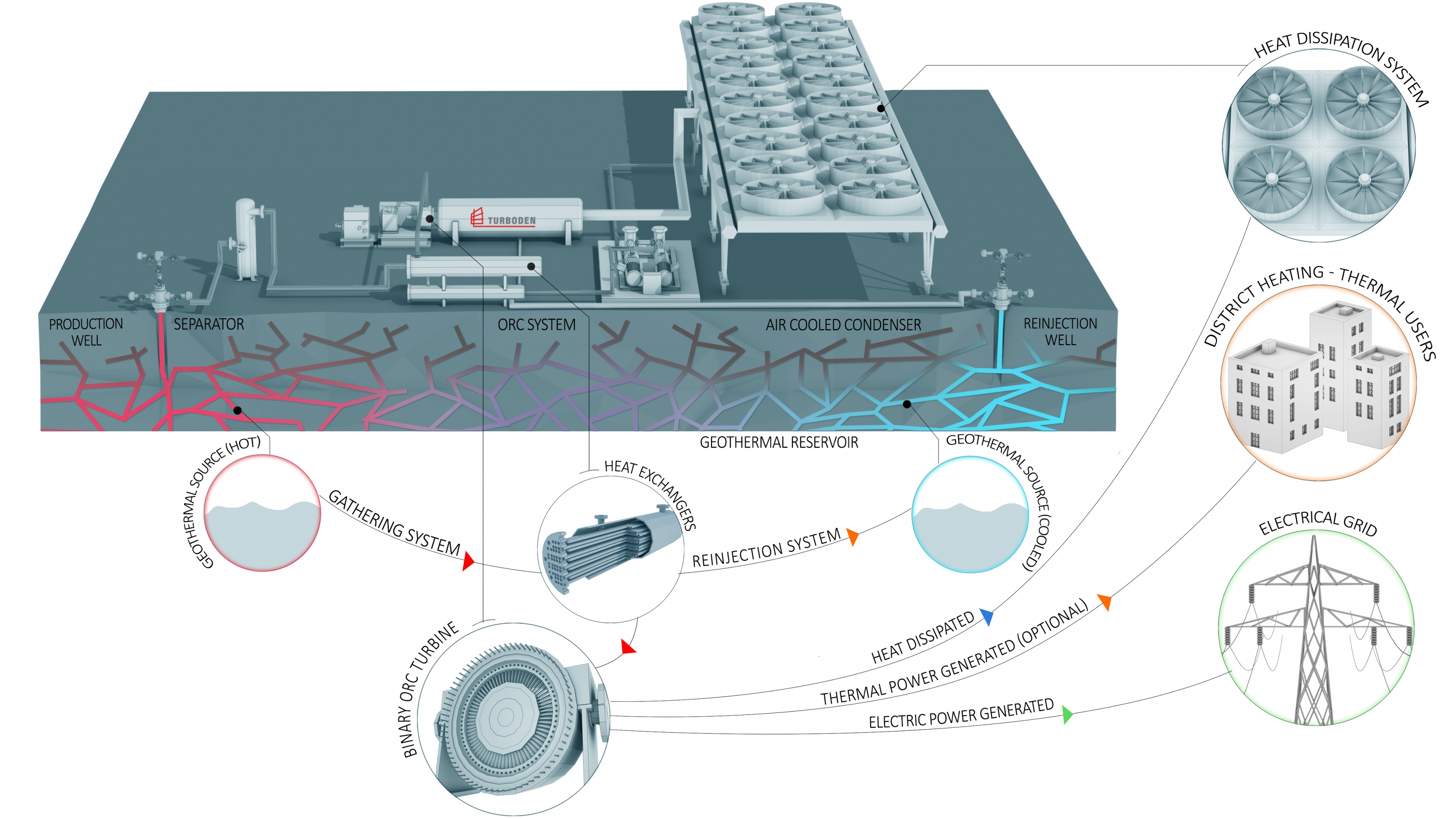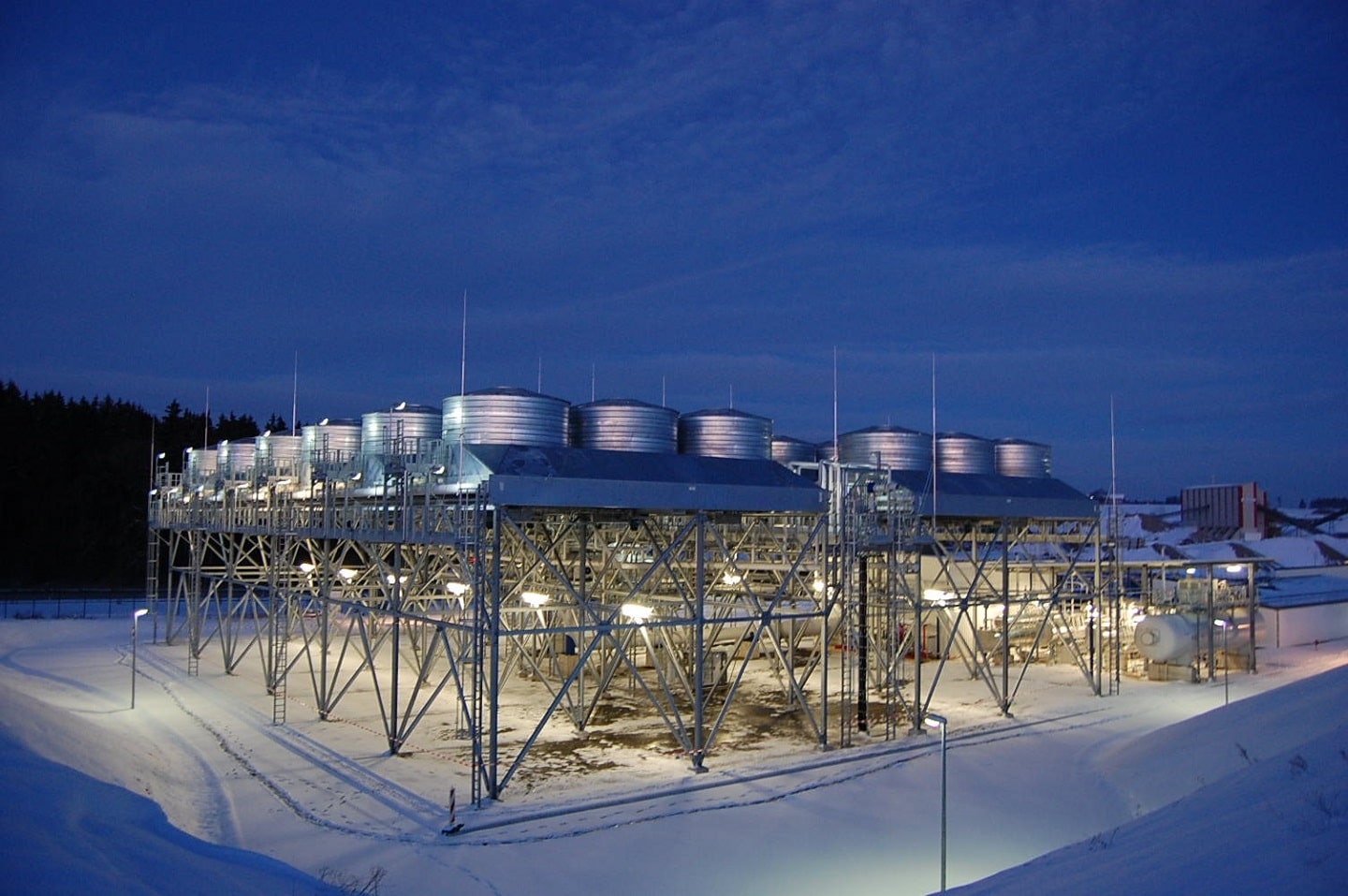Geothermal
The ORC technology is particularly suitable for the exploitation of medium-to-low enthalpy sources. It is a cost-effective solution with power outputs reaching up to 40 MWe per single generator for sources with water temperature from 100°C to 200°C or higher.
20
plants*247.3
MWe total2000
first plant delivered*6 plants are under construction
-
TURBODEN GEOTHERMAL APPLICATION
-
VELIKA CIGLENA - 17.5 MW GEOTHERMAL POWER PLANT
-
LIGHTNING DOCK - 14 MW GEOTHERMAL PLANT
Binary geothermal ORC plant with closed loop

GEOTHERMAL SOURCE
Heat from the ground can be used as an energy source and it can be found in many regions of the world, especially at tectonic plate boundaries or at places where the crust is thin enough to let the heat through. The most common way of capturing energy from geothermal resources is to tap into naturally occurring hydrothermal convection systems, where cooler water seeps into earth’s crust and is heated up within a reservoir.

- Average plant availability: 98% on all the fleet in operation
- Complete in-house design (above ground process and technology)
BINARY ORC TECHNOLOGY
Binary ORC plants use heat exchange to exploit geothermal fluid to heat up and vaporize a secondary organic fluid that drives a turbine and produces electric power. In this way, the geothermal fluid remains within a closed loop of piping (from the reservoir to the reinjection) without passing through the turbine, with no harmful emissions into the atmosphere. The heat that is not converted into electricity can be delivered to a thermal user or dissipated through a suitable cooling system. ORC is very effective for exploiting resources with high steam fractions at locations where it is not convenient to collect and deliver all the fluids to a centralized station, but preferable to employ modular well-head units. Existing single-flash power plants can be improved by adding an ORC system on the separated brine stream, before reinjection. This makes it possible to produce more power from the same geothermal resource.
WHY SELECTING A FLUID DIFFERENT FROM WATER
By selecting a “lower boiling fluid” rather than water it is possible to efficiently exploit also heat sources within the range of 100 °C to 200 °C. Thermodynamic cycle configurations, which are inaccessible in the state diagram of water, can be obtained with organic fluids having different parameters, and with high efficiency.
ADVANTAGES
- Zero emissions and full reinjection achievable
- No corrosion and no scaling in the turbine: geo fluid remains outside the binary loop
- High steam and brine heat conversion with binary cycle efficiency up to 25%
- Multi-stage axial turbine
- Less sensitive than radial turbines to ambient temperature variations, showing nearly constant efficiency over a wide range of operating conditions
- The most widely adopted in turbomachinery design, proven with billions of working hours worldwide
- More than 90% turbine isentropic efficiency achieved
- More than 60 different turbines developed on 4 standard frames
- 10 different working fluids (hydrocarbons, HFCs, HFOs)
- Patented seal and bearing replacement system
- Direct drive: rotation speed from 1,500 rpm to 3,000 rpm
- Robust design, low vibration, and strict quality tests in collaboration with the Mitsubishi team
OUR EXPERIENCE
- Capacity: Solutions up to 40 MW per single generator
- Temperature range: from 100 °C to more than 200 °C
- Working fluids: Hydrocarbons, HFCs, HFOs
- Thermodynamic process and control philosophy designed by Turboden
- Turbine type: Axial multi stage, Turboden proprietary design
- Key equipment designed in house (e.g. Air Cooled Condenser and Heat Exchangers)
- Operation in remote areas: off grid capability (island mode) and active grid balancing
- Combined heat and power solutions
TYPICAL SOLUTIONS
| ORC size | location | customer | status | notes |
|---|---|---|---|---|
| 0.5 MWe | Livorno, Italy | Enel | off | Supercritical prototype |
| 1 MWe | Altheim, Austria | Marktgemeinde Altheim GmbH | In operation since 2001 | Heat & Power |
| 1.7 MWe | Soultz-sous-Forêts, France | GEIE - Exploitation Minière de la Chaleur | In operation since 2016 | Electric power production |
| 11 MWe | France | Fonroche Geothermie | Under construction | Electric power production |
| 14 MWe | Animas, United States of America | Cyrq Energy Inc. | In operation since 2018 | Electric power production |
| 17.5 MWe | Velika Ciglena, Bjelovar, Croatia | Geoen d.o.o. | In operation since 2018 | Electric power production |
| 3 MWe | Afyonkarahisar, Turkey | Afjet (Afyon Jeotermal) | In operation since 2016 | Electric power production |
| 3.4 MWe | Holzkirchen, Germany | Geothermie Holzkirchen GmbH | In operation since 2019 | Heat & Power |
| 8 MWe | El Salvador | LaGeo | Under construction | Electric power production |
| 4.1 MWe | Traunreut, Germany | Geothermische Kraftwerksgesellschaft Traunreut GmbH | In operation since 2016 | Heat & Power |
| 5 MWe | Sauerlach (Munich), Germany | SWM - StadtWerke München | In operation since 2013 | Heat & Power |
| 5.6 MWe | Duerrnhaar (Munich), Germany | SWM - StadtWerke München | In operation since 2012 | Electric power production |
| 5.6 MWe | Kirchstockach (Munich), Germany | SWM - StadtWerke München | In operation since 2013 | Electric power production |
| 6 MWe | Japan | Mitsubishi Heavy Industries | In operation since 2015 | Electric power production |
| 8.2 MWe | Geretsried, Germany | Eavor Erdwärme Geretsried GmbH | Under construction | Electric power production |
| 29 MWe | Philippines | Bac-Man Geothermal Inc. | In operation since 2024 | Electric power production |
| 3.7 MWe | Germany | E.ON Business Solutions GmbH / FG Geothermie GmbH | In operation since 2022 | Electric power production |
| 40 MWe | Milford, UT, United States of America | Cape Generating Station 1 LLC / Fervo Eneergy | Under construction | Electric power production |
| 40 MWe | Milford, UT, United States of America | Cape Generating Station 3 LLC / Fervo Eneergy | Under construction | Electric power production |
| 40 MWe | Milford, UT, United States of America | Cape Generating Station 3 LLC / Fervo Eneergy | Under construction | Electric power production |
Other Solutions
ENERGY EFFICIENCY
RENEWABLES










